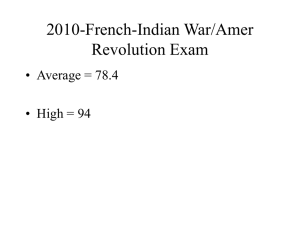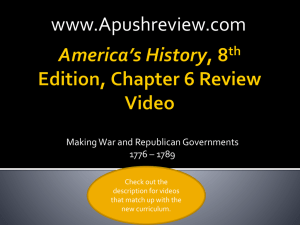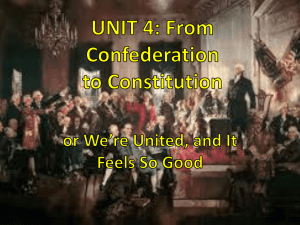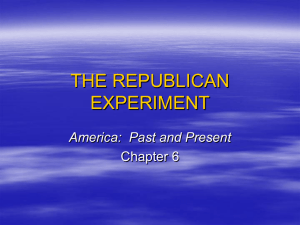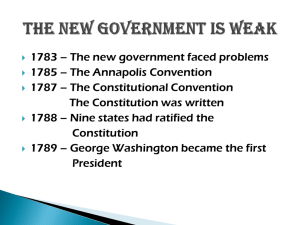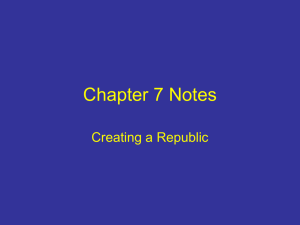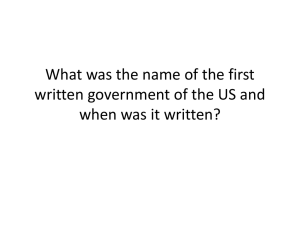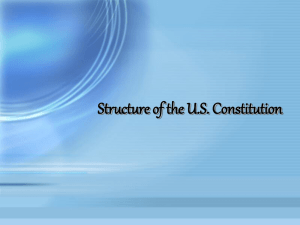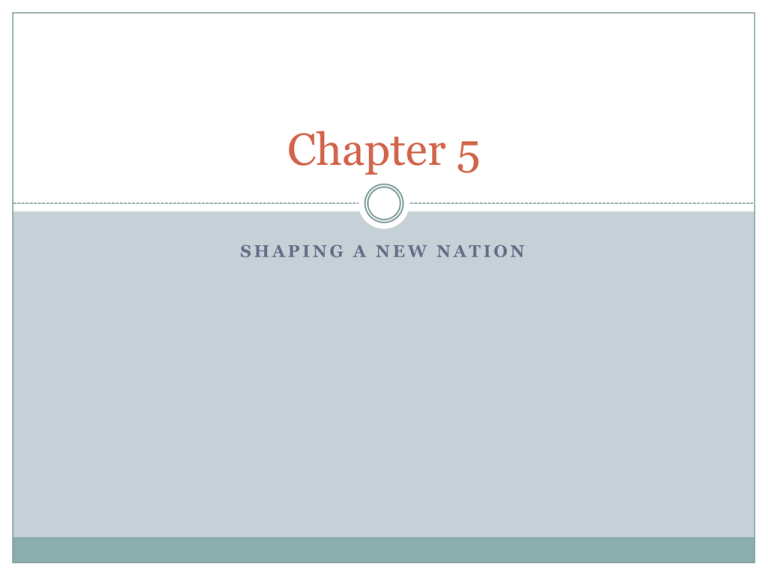
Chapter 5
SHAPING A NEW NATION
5.1: Experimenting with Confederation
One American’s Story (pg. 132):
Who is the main orator of the passage?
What is the main idea of the passage?
When did this take place?
Where did this take place?
Why did this take place?
Terms to know…
Republic
Republicanism
Articles of Confederation
Confederation
Land Ordinance of 1785
Northwest Ordinance of 1787
Americans Debate Republicanism
One key issue the Congress had to settle was the
relationship between the state and national govts
To most people, the colony was the primary govt
prior to independence, therefore many believed that
the state govt should be more powerful that the
newly created national govt in America
18th Century Americans felt that there were too many
dumb people living there, and therefore did not want
a democracy, hence they favored a republic
Republicanism (not the political party today) swept
throughout the states
Americans Debate Republicanism
There were two schools of thought about how to
achieve this:
The govt could only succeed if people placed the nation above
their personal interests
The govt would succeed if people were left free to pursue their
own political/ economic interests
The 13 states began to draft their individual
constitutions—most focused on limiting govt,
emphasized liberty rather than equality—differed on
suffrage (race, sex, wealth)
The Continental Congress Debates
The Continental Congress began drafting a national
constitution; three basic questions arose
1. Representation by population or by state?
The states were all different (population, wealth, size); they
decided that each state should get one vote, regardless of its
total population
2. Can the supreme power be divided?
People assumed that a national govt couldn’t share its power
w/ lesser govts (states); Articles of Confederation was drafted=
a Confederation (loose union of strong state govts)
3. Who gets the uncharted western lands?
Maryland would not agree to the Articles of Confederation
until all states gave up any western land claims to the natl govt
The Continental Congress Debates
To est. governing rules for the western land, Congress
passed the Land Ordinance of 1785 (turn to pg. 138)
The Northwest Ordinance of 1787 further divided this
land into territories, and set requirements as to how
these lands might one day become states (did not
account for Native Americans)
A district could become territory with a population of 5,000 adult
males. Then could send a nonvoting representative to Congress
A territory could write a constitution and apply for statehood
with a population of 60,000.
These two land ordinances were the Confederation’s
greatest achievements
Land
Ordinance
of 1785
• Congress
surveyed the
land into
squares 6
miles on
each side.
(townships)
Land
Ordinance
of 1785
• Each town
was divided
into 36
smaller
sections, 640
acres each.
(the cost was
a minimum
of $1 per
acre)
Land
Ordinance
of 1785
• People
pooled their
money in
order to be
able to
afford a
piece of
land.
Theoretical
township
diagram
showing
method of
numbering
sections with
adjoining
sections.
Township Map
Sargent County, North Dakota
Northwest Ordinance (1787)
• When 5,000 free
males of voting age
settled an area, it
became selfgoverning.
• When the population
reached 60,000 free
citizens, the area could
apply for statehood.
Ex.) OH, IN, IL, MI,
WI
• Slavery was outlawed.
Objective: To examine the
formation of the Articles of
Confederation
The Articles of Confederation (1781) - the first central
government of the United States
Congress was a unicameral legislature with delegates, or
representatives, from each state.
- The main power of Congress involved foreign affairs.
- All 13 states had to agree on all amendments.
- 9 of the 13 states had to agree on all federal laws.
* Under the Articles of Confederation, the states had more
power than the federal government.
Examples: taxation and law enforcement
* The Articles of Confederation had a weak
federal government on purpose because they
were afraid of their experiences with the British
monarchy and Parliament.
The Confederation Encounters Problems
After the initial success of territorial expansion
issues, the Confederation began showing it’s
weakness when dealing w/ taxation, national debt,
Congressional representation, etc.
The Articles of Conf. caused Americans to see
themselves as individual states, not one nation
The 1 vote per state rules hurt states w/ large
populations (Ga (23,375)= Mass (235,308)
Most serious economic problem was the national
debt stemming from the war ($190 million)—had to
pay back foreign nations/ Continental currency
worthless
Couldn’t tax or collect revenue from the states
Borrowers
(Debtors)
VS
Lenders
(Creditors)
After the war, Creditors (lenders of $) and debtors
(borrowers of $) struggle against one another.
Lenders favor high taxes so the states can pay them back--this sends farmers into debt and many lose their farms
because of it.
Usefulness of Money- Debtors want to increase the supply
of money to lessen its value and enable them to pay off their
debts with cheap currency.
Creditors want the money supply low so it would keep its
full value.
Foreign-Relations Problems
US does not pay debts to British merchants or compensate
Loyalists
In retaliation, Britain refuses to evacuate forts on the
Great Lakes
In 1784, Spain closes Miss. River to American navigation
Westerners unable to ship crops east through New Orleans
Congress unable to resolve problems with foreign nations
Answer the following questions by reading “What
was Shays Rebellion”
Explain how war could be both good and bad for a
country, and then clarify how the Articles of
Confederation showed its weakness after the
American Revolution.
2. Identify how class warfare was prominent in
America during 1786.
3. Who is Daniel Shays, and what did he do?
4. Put in plain words how did Thomas Jefferson
reacted to Shays' Rebellion?
1.
5.2: Drafting the Constitution
One American’s Story (pg 140):
Who is the main orator of the passage?
What is the main idea of the passage?
When did this take place?
Where did this take place?
Why did this take place?
Terms to Know…
Shays’ Rebellion
James Madison
Roger Sherman
Great Compromise
Three-Fifths Compromise
Federalism
Legislative Branch
Executive Branch
Judicial Branch
Checks and Balances
Electoral College
Compromise….
“A truly good compromise is when all parties
involved are equally dissatisfied with the solution”
Shays’ Rebellion
• Farmer’s income
decreased while taxes
increased.
• Farmers who could not
pay their debts had their
farms taken away by
debtors courts.
Massachusetts farmer
Daniel Shays and his
supporters occupy a
Massachusetts courthouse.
• Therefore, in 1786, Daniel Shays led a group of farmers in
an attempt to capture a federal arsenal.
Men Fighting
During Shays'
Rebellion
• The U.S., without an organized army, was powerless.
Massachusetts sent a militia to stop the rebellion.
• Shays’ Rebellion convinced many people that the U.S.
needed a new, stronger government.
• The Articles of Confederation needed to be replaced!
This is a picture of Daniel Shays grave in Scottsburg, NY.
Nationalists Strengthen the Govt
Each state had a large pop of debt-ridden farmers—
would Shay’s Rebellion spread from a one-time
incident in Massachusetts to more states?
The rebellion proved that there needed to be a stronger
national govt to handle such situations
Biggest issue: trade b/t states (taxes, navigation, etc)
James Madison & Alexander Hamilton called for a
meeting to decide how to fix the national govt
May 1787 12 states (not Rhode Isl) set delegates (55
total) to Pennsylvania State House (same room as Dec. of
Ind. 11 years earlier)—these were high class, educated
men; Washington was elected presiding officer
The convention met to revise the Articles of Confederation,
however they decided to scrap it all together and form a brand
new govt—there were two big issues that had to be resolved…
Big States vs. Small States
Slavery-Related Issues
Madison’s Virginia Plan:
Representation based on pop
bicameral legislature w/
membership based on pop—
smaller states rejected
Patterson’s New Jersey Plan: A
unicameral legislature w/ each
state had one vote—large states
rejected
Roger Sherman’s Great
Compromise blended the
two: two-house Congress—
Senate equal representation/
House based on population.
Citizens elected House; state
leg would elect Senate
highlighted key dilemma—
would slaved be counted as
people?
Southern states wanted b/c
high concentration of slaves,
thus more representation—
northern states disagreed
Three-Fifths Compromise:
3 out of 5 (60%) of slave pop
would be counted for rep.
Plantation owners feared that
Congress would outlaw slave
trade—Congress agreed not to
interfere w/slave trade for 20
yrs
Creating a New Govt
The newly formed govt would be a form of federalism, in
which the state and federal govt would share power
Powers
granted to the
states are
called
reserved
powers
Powers granted
to the federal
govt were called
delegated or
enumerated
Both levels of
govt also share
powers
Procedure for electing a president
Communication was difficult; most citizens would
vote for “their” regional person for president; upper
class believed the lower class was not smart enough
to make such an important decision. Therefore, the
framers of the Constitution didn’t want the popular
vote to elect the President (too bad for Al Gore in
2000)
The Founders came up w/ a system known as the
electoral college, where a group of electors from each
state would cast ballots for presidential candidates
Understanding today’s Electoral College
Each state is given a
number based on its total
population;
The total number of all
the states = 538…why?
Senate (100) + House
(435) + Wash DC (3) =
538
A majority ( 1 more than
½) would be 270—who
ever gets to 270 first wins
the presidency
Saxby Chambliss
Johnny Isaacson
Tom Price
5.3: Ratifying the Constitution (pg 145)
One American’s Story:
Who is the main orator of the passage?
What is the main idea of the passage?
When did this take place?
Where did this take place?
Why did this take place?
Terms you’ll need to know…
Ratification
Federalists
Antifederalists
The Federalists
Bill of Rights
Federalists and Antifederalists
Citizens were shocked to see the changed the delegates
made in the 4 months creating the Constitution—most
thought they would only tweak the Articles of
Confederation (painting a room in your house vs tearing
down house/ build new one)
To approve the newly drafted Constitution, each state
had to elect delegates, and hold a special convention to
either ratify or reject the Constitution; once 9 states
approved ratification, the Constitution would become law
Federalists—those that favored the Constitution; good
balance b/t federal & state govts
Antifederalists —those that opposed the new govt;
thought it gave too much power to the federal govt
Federalist viewpoint
Led by James Madison, John Dickinson, and Alexander
Hamilton
Benjamin Franklin and George Washington also backed the
Federalists.
The Federalist- series 85 essays defending the Constitution—
aimed at getting public support
• Federalist cause was generally popular in the cities, but they
were outnumbered in the general population.
• Well organized and knew how to gather political support
• Believed that the system of checks and balances would keep
the govt in check
Antifederalists
Antifederalists viewpoint
• They were less organized and less unified than the Federalists.
• Their core consisted of farmers and planters.
• Agreed on one central issue: they distrusted any central authority
• Believed strong national government would lead to a kind of
tyranny like the kind they fought against in the Revolution.
• Worried that the government would abuse both states’ rights and
individual liberties
• Thought the new government favored the educated and wealthy
over ordinary people
• Led by Samuel Adams, Patrick Henry, and Richard Henry Lee
• Robert Yates, New York delegate, wrote anti-Constitution essays
under the name Brutus
• They wanted basic human rights added to the Constitution…a Bill of
Rights
The Bill of Rights Leads to Ratification
Antifederalists pushed for a national bill of rights to
protect the citizens from the powerful natl govt
The Federalists promised to add a bill of rights later if
the states would go ahead and approve ratification
Delaware led the states in ratification, and New
Hampshire completed it by being the 9th state to ratify
the Constitution in June 1788
Two very important states (New York and Virginia)
had not voted, and their support was desperately needed
in order for the govt to be successful.
July 1788—all of the states had ratified the Constitution
by 1789, due in large part of a promise to add a Bill of
Rights
Ratification issues
In Virginia, Patrick Henry, Richard Henry Lee, and
James Monroe led the Antifederalists debate
In New York, John Jay, Alexander Hamilton, and James
Madison led the debate for the Federalists
Congress submitted the Bill of Rights in Sept. 1789,
and by Dec. 1791 the required ¾ of the states had ratified
them
Amendments 1-8 spell out personal liberties
Amendments 9-10 impose general limits on the power of
the federal govt.
The Constitution’s flexibility enable it to be continually
changed, which is why it is still a working document
today.
Unit Essential Question # 3
What factors shaped the adoption
and implementation of the United
States Constitution?
Turn to page 150 in the textbook
Read each one of the Main Idea questions (1-10)
Be ready to answer specific questions about each of
those ten questions.
The executive, the legislative, and the judicial
branches prevent any one branch from dominating
the others.
7
A huge debt from the Revolutionary War, not power
to tax, no control over international or foreign trade,
and no power to deal with foreign relations
3
They believed the states and the individual rights of
citizens were sufficiently protected
10
They were afraid that a democracy placed power in
the hands of the uneducated masses.
1
Southern states feared if Congress were given the
power to regulate foreign trade, it might not allow
the slave trade.
6
It was a series of essays that analyzed the
Constitution and explained why ratifying it would be
beneficial.
9
The weakness of the govt, the huge debt, the inability
to levy taxes, Shays’ Rebellion, and problems with
foreign nations.
4
They had just fought a Revolutionary War to free
themselves from the strong central govt of Great
Britain
2
Big and little state compromised; the Three-Fifths
Compromise settled the issues of counting slaves
5
For: It created a strong central govt but reserved
powers for the states and created a system of checks
and balances for the central govt
Against: Strong central govt might increase taxes;
citizens’ rights/ freedoms not protected enough
8


